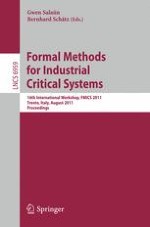This book constitutes the proceedings of the 16th International Workshop on Formal Methods for Industrial Critical Systems, FMICS 2011, held in Trento, Italy, in August 2011. The 16 papers presented together with 2 invited talks were carefully reviewed and selected from 39 submissions. The aim of the FMICS workshop series is to provide a forum for researchers who are interested in the development and application of formal methods in industry. It also strives to promote research and development for the improvement of formal methods and tools for industrial applications.
